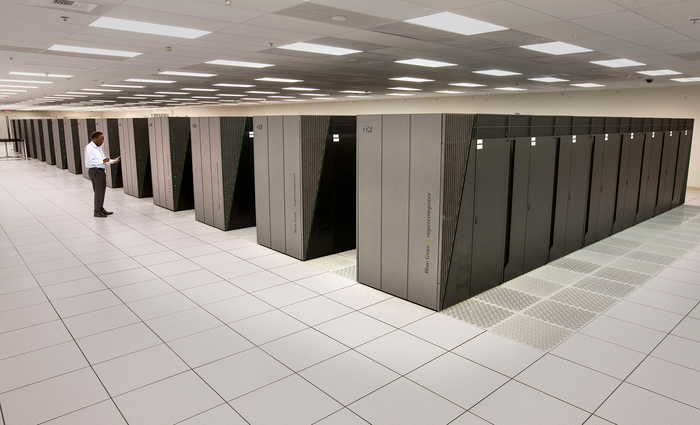Sequoia supercomputer enables Gordon Bell Prize-winning simulation on Earth's mantle
 (Download Image)
The Sequoia supercomputer played a key role in the Earth mantle convection simulation by a University of Texas-led team that won the 2015 Gordon Bell Prize at this year’s Supercomputing Conference (SC15).
(Download Image)
The Sequoia supercomputer played a key role in the Earth mantle convection simulation by a University of Texas-led team that won the 2015 Gordon Bell Prize at this year’s Supercomputing Conference (SC15).
The full power of Lawrence Llivermore’s Sequoia supercomputer played a key role in the Earth mantle convection simulation by a University of Texas-led team that won the 2015 Gordon Bell Prize, announced at this year’s Supercomputing Conference (SC15).
The team’s peak performance results were achieved on the full Sequoia system last summer, and the weak and strong scaling results figured prominently in the team’s presentation at the SC15 conference in Austin, Texas.
LLNL’s onsite IBM analyst Roy Musselman and Livermore Computing’s Scott Futral were acknowledged for their contributions to the project in carrying out the Sequoia calculations, as was the system access granted by DOE/NNSA.
High performance computing (HPC) innovations advancing the state of the art enabled the most accurate simulations yet of mantle convection, the fundamental physical process within Earth’s interior responsible for the thermal and geological evolution of the planet, including plate tectonics.
Entitled, "An Extreme-Scale Implicit Solver for Complex PDEs: Highly Heterogeneous Flow in Earth’s Mantle," the winning submission was led by Johann Rudi from the University of Texas at Austin with a team including IBM, the Courant Institute of Mathematical Sciences, University of Texas at Austin, and the California Institute of Technology.
"I’m gratified that Sequoia continues to contribute to groundbreaking calculations in computational science," Futral said.
"LLNL occasionally conducts full-system calculations using a diverse set of codes to better understand the system architecture," notes Mike McCoy, Weapon Simulation and Computing Program director. "This run was exemplary of a calculation that stresses the system, that allows us to better understand its operating parameters and that, as a bonus, demonstrates NNSA’s continued leadership in the area of siting highly functional computers. What we learn about system architecture serves to enhance the capabilities we dedicate to our national security missions."
Sequoia, a 20 petaflops (quadrillion floating point operations per second) IBM Blue Gene/Q system, remains the No. 3 HPC system on the Top500 list of the world’s most powerful computers.
A team led by Amanda Randles, formerly of LLNL and now at Duke University, was among the finalists for this year’s Gordon Bell Prize with a project to model the human circulatory system. Other co-authors of "Massively Parallel Models of the Human Circulatory System" include Erik Draeger, Tomas Oppelstrup and Liam Krauss of LLNL, and John Gunnels of IBM.
The Gordon Bell Prize is awarded each year at SC to recognize outstanding achievement in high-performance computing. The purpose of the award is to track the progress over time of parallel computing, with particular emphasis on rewarding innovation in applying high-performance computing to applications in science, engineering, and large-scale data analytics.
Contact
Don Johnston[email protected]
925-423-4902
Related Links
Winning Gordon Bell submissionSequoia
Advanced Simulation and Computing program
Tags
HPC, Simulation, and Data ScienceHPC
Computing
Featured Articles







